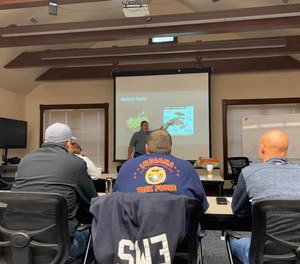
First responders from 23 agencies attended training in Cass County on the hazards of li-ion batteries
Pharos-Tribune
LOGANSPORT, Ind. — Responders from 23 different agencies came to Logansport this past weekend to learn strategies from nationally-recognized speakers for dealing with hazardous incidents involving lithium-ion batteries.
Two offerings of the training were held, one Friday evening and one Saturday morning according to a press release from the Cass County Emergency Management Agency, which sponsored the training.
Rocky Buffum, director of Cass County Emergency Management, credited Logansport Fire Chief Rick Bair with suggesting the training.
"Chief Bair, as part of the Local Emergency Planning Committee, expressed interest in bringing this training in for local responders.," Buffum said. "The EMA Staff had previously attended training at a state conference and were familiar with some vendors that specialized in this area, and had already began purchasing equipment. EMA put the grant request together, got approval, and Logansport Fire Department provided the location. The long list of participating agencies shows there is concern across the area about this new challenge and how to deal with it."
Training was conducted by Noble and hosted at the Logansport Fire Department. The bulk of the funding — $5,000 — was provided through a Public Safety Training and Education Grant from NIPSCO. The remainder of funding was provided by the Emergency Management Agency using revenue generated from HAZMAT Response billing.
Lithium-ion batteries are used in a variety of applications. These range from small applications, such as cell phone or remote-control batteries, to larger applications such as vehicles and home power walls. Also, a facility in neighboring Howard County will soon be opening which mass produces these batteries.
When they operate normally, they are an accepted part of daily life. When batteries are damaged, break down over time, or enter a process known as "thermal runaway," they pose unique hazards for emergency responders.
These hazards include higher than normal burning temperatures, highly flammable gasses given off during decomposition, and the tendency to reenter thermal runaway hours or sometimes days after fires had been extinguished. When these events occur inside homes, such as an electric vehicle inside a garage or a hoverboard inside a bedroom, it further complicates emergency response. Burning batteries and other debris can be launched a significant distance across a room or open area and start secondary fires. In some cases explosion hazards can be generated.
10 takeaways from UL’s FSRI lithium-ion battery symposium
The event underscored the need for additional research, plus enhanced training and situational awareness, related to this hazard
Topics covered in the training included the dangers associated with various applications, as well as special equipment needed for certain situations. As an example, when an electric vehicle catches on fire the traditional approach of simply spraying water on it doesn't work. The way the battery packs are built, and where they are located makes it very difficult for water to get to the problem area. Additionally, these fires burn much hotter than normal car fires requiring significantly more gallons per minute to overcome the British Thermal Units (BTUs) of heat given off. Even after extinguished a battery cell can reignite hours or days later and start the process again.
To answer this hazard, special equipment is needed. During the training the EMA exhibited a specialized tarp it has added to the county HAZMAT Response trailer. This is specifically designed to contain fire from burning electric vehicles. It also exhibited containment drums it has purchased for lithium-ion batteries, which keep restarted reactions contained if they do "fire off" again after the initial emergency response.
Lithium-ion battery construction: Firefighters should know the differences
From chemical make-up to cell construction, not all lithium-ion batteries are the same
In the press release, Buffum said EMA anticipates a planning meeting with other public safety agencies focusing specifically on Cass County's strategy to prepare, including acquisition of more equipment and procedures for how that equipment is requested and used.
Participating agencies included: Buffalo-Liberty Township Fire Department, Cass County Emergency Management Agency, Cass County Emergency Medical Services, Cass County Fire District 1, Center Township Fire Department (LaPorte), Clinton Township Fire Department, Frankfort Fire Department, Galveston Fire Department, Georgetown Fire Department, Greentown Fire Department, Harrison Township Fire Department (Lucurne), Henry Township Fire Department, Kewanna Fire Department, Logansport Fire Department, Logansport Memorial Hospital, New Waverly Fire Department, Peru Fire Department, Pulaski County Emergency Management Agency, Royal Center Fire Department, Tippecanoe Township Fire Department, Twelve Mile Community Fire Department, Walton Community Fire Department, and Warsaw-Wayne Fire Territory.
(c)2023 the Pharos-Tribune (Logansport, Ind.)
Visit the Pharos-Tribune (Logansport, Ind.) at
www.pharostribune.com
Distributed by
Tribune Content Agency, LLC.
McClatchy-Tribune News Service
Copyright © 2025 FireGrantsHelp.com. All rights reserved.

